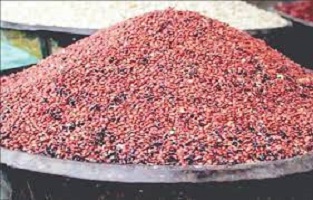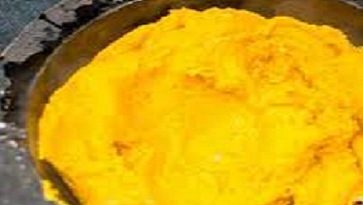Benefits of Guinea Corn (Sorghum) for Adult & Babies | Effects
Benefits of Guinea Corn (sorghum) for Adult & Babies | Side Effects

- Health Benefits of Guinea Corn Pap for Adult & Babies | Side Effects
- Guinea Corn Health Benefits: Guinea Corn Benefits
- Nutrition Facts and Health Benefits of Sorghum
- Health Benefits and Side Effects of Guinea Corn (sorghum)
Guinea corn, often known as sorghum, is a gluten-free, high-protein cereal from the Poaceae grass family.
It is one of the most important cereal crops in the world, coming in fifth place behind maize, wheat, rice, and barley in terms of production. There are two types of guinea corn: white guinea corn and red guinea corn.
I’m not familiar with the differences between white and red guinea corn. If you have any information, please share it with me in the comments section below. I look forward to hearing from you.
Guinea corn is a staple food in many African households and is the preferred weaning diet for newborns. In Nigeria, it’s known as guinea corn or dawa, while in India, it’s known as jowar.
This underappreciated crop is high in fiber and phenolic chemicals, both of which have been linked to the prevention of heart disease and metabolic problems.
Table of Contents
Nutritional value of Guinea corn: Sorghum Nutritional Values
Sorghum has elements that make it suitable for human diets, such as:
1 cup (192 grams) of raw sorghum grain provides:
- Calories: 632 kcal
- Protein: 20 grams (g)
- Fat: 7 g
- Carbohydrates: 138 g
- Dietary Fiber: 12 g
- Thiamine: 0.6 milligrams (mg)
- Riboflavin: 0.1 mg
- Pantothenic acid: 0.7 mg
- Vitamin B6: 0.8 mg
- Copper: 0.5 mg
- Iron: 6 mg
- Magnesium: 317 mg
- Phosphorus: 555 mg
- Potassium: 697 mg
- Zinc: 3 mg
- Calcium: 25 mg
- Manganese: 3 mg
Sorghum Vs Wheat
People frequently compare sorghum to wheat because of their similar characteristics, despite the fact that both are whole-grain cereal foods. Their grasses are mostly grown for their seeds.
Wheat and sorghum both have no cholesterol and are high in important vitamins, minerals, carbs, protein, and other nutrients that benefit human health.
Health Benefits of Millet and Guinea Corn
Because the trio combination makes ogi a more nutritious meal for infants, the intended blends (maize, millet, and guinea corn) are used for ogi production.
Corn is mostly a carbohydrate source, while millet and guinea corn provide proteins, vitamins, and minerals that are essential for newborn growth.
Here’s why you should feed your newborn guinea corn. Health Benefits of Guinea Corn for Babies
Guinea corn is cellulose and protein-rich dietary energy inducer. Guinea corn contains vital proteins, vitamins, and minerals for human growth and development. We’ll look at the advantages of guinea corn for babies’ health.
We’ll look at the advantages of guinea corn for babies’ health.
Guinea maize, like many other pantry staples in Nigeria, is prized not only for its delicate and distinct flavor, but also for its numerous health advantages. Sorghum can make you feel better in the following ways:
Benefits of Sorghum
The following are some of the health benefits of eating guinea corn:
- Provides necessary minerals and nutrients
Iron and B vitamins (thiamine, riboflavin, Panthothenic acid, and others) are abundant in sorghum.
It’s also high in minerals like magnesium, potassium, phosphorus, and calcium, which are needed for bone building, heart health, and over 600 metabolic reactions in the body.
Most significantly, sorghum (guinea corn) is a high-protein food that contains the same amount of protein as quinoa.
- Helps to prevent diabetes
The whole grain of Guinea corn (sorghum) is a great diet for diabetics.
The starch digestibility of sorghum is poor. This is due to the large concentration of resistant and poorly digesting starch in the endosperm.
Sorghum also contains condensed tannins, which can react with carbohydrates and proteins in the gastrointestinal tract to create bulk compounds. These digestive tract complexes give you a feeling of fullness or satiety while also lowering your glycemic response.
In addition, consuming sorghum muffins influenced glucose and insulin levels, as well as improved glycemic response in healthy adults, according to a study.
- Helps to prevent cancer
The high antioxidant activity of sorghum’s phenolic chemicals may be responsible for its anticancer properties. Tannins and 3deoxyanthocyanidins are examples of phenolic chemicals.
Sorghum tannins have been demonstrated in studies to inhibit aromatase (a breast cancer-related enzyme) and so prevent cancer growth.
Tannins extracted from sorghum were also found to be more efficient than tannins extracted from grape seed in inhibiting the proliferation of colon cancer cells.
- Helps to prevent obesity
In the digestive tract, Guinea corn components form complexes with starch and protein, providing a feeling of fullness or satiety and reducing overeating.
According to a recent study, healthy persons who ate sorghum whole grain biscuits felt more satiety and less hunger than those who ate wheat biscuits.
- It has anti-inflammatory properties.
Long-term oxidative stress can cause chronic inflammation, which can lead to a variety of chronic diseases.
Interleukin (IL), cyclooxygenase (COX)2, tumor necrosis factor (TNF), and prostaglandin E2 (PGE2) are among the pro-inflammatory chemicals produced during inflammation.
The formation of these pro-inflammatory chemicals has been shown to be inhibited by many phenolic compounds found in sorghum grains.
- It has antioxidant properties.
Most chronic diseases are caused by oxidative stress, which is caused by an imbalance of antioxidants and free radicals.
Sorghum is a grain that enhances health and prevents the majority of chronic diseases.
- It protects against heart disease.
Fat (lipids) found in Guinea corn (sorghum) grains have been demonstrated to improve cardiovascular health by controlling cholesterol absorption, excretion, and synthesis.
Incorporating sorghum lipids into the diet of hamsters (rats) enhanced cholesterol and its metabolite excretion, lowering plasma and liver cholesterol levels in the hamsters, according to a recent study.
Antioxidants included in whole grains help to prevent cardiovascular disease.
- Aids in the prevention of celiac disease
Sorghum is gluten-free, unlike other main gluten-containing cereal crops like wheat and barley, and offers a potential and safe alternative food source for persons with celiac disease.
- Helps to prevent constipation
Guinea corn contains a significant amount of dietary fiber, which aids in the correct functioning of the digestive system.
A diet high in dietary fiber also lowers the risk of cardiovascular disease and colon cancer.
- It helps to maintain bone health.
Calcium and magnesium, two vital minerals for strong bones, are abundant in sorghum.
Calcium absorption is aided by magnesium. Osteoporosis and arthritis are caused by a calcium or magnesium shortage.
Guinea Corn: How to Use It
You may be wondering how to incorporate guinea corn into the adult menu now that you know how to feed it to your baby as brown pap or other baby-friendly recipes.
One of the most typical methods to consume sorghum is to grind it into flour, which can then be used in baking, cereal, and the preparation of delectable breakfast pancakes.
A famous welcome drink made with ground guinea corn, water, spices, and shea butter is also popular. Guinea corn can also be successfully used as a garnish in casseroles and other dishes.
Culinary applications
Sorghum is a versatile grain that may be used in a variety of dishes.
Ways you can enjoy Sorghum
You can enjoy it in a variety of ways, including:
- Baby weaning food (ogi or pap): You may produce a healthy weaning diet for infants by fermenting guinea corn with pearl millet and maize.
- Quinoa or rice can be used in place of rice. Cook whole grain and pearled sorghum in the same way you would rice and quinoa
- Flour made from sorghum. It may easily be used as a gluten-free flour in most recipes due to its neutral flavor and light color. To make pancakes, roti, tortillas, biscuits, and bread, simply use it alone or in a 1:1 ratio.
- Popped. In a hot skillet, toss the grains and watch them pop like popcorn. Seasonings can be used for added flavor.
- Syrup. Sorghum syrup is used as a natural sweetener or as a substitute for molasses in processed meals (sugar cane syrup).
- Beer: Sorghum is used to make “burukutu,” a fermented alcoholic beverage popular in Nigeria and other parts of Africa.
As you can see, there are numerous ways to enjoy guinea corn’s flavor and numerous health advantages!
Sorghum Side Effects
Given all of these facts about sorghum’s health benefits, the question remains: may sorghum cause harm to the human body? However, everything in life has two sides, and in most cases, the positive sides outweigh the negative parts, i.e. The following are some of the possible adverse effects.
- Firstly, people who are prone to or suffer from gastrointestinal disorders should avoid high-fiber goods like sorghum extract.
- Breastfeeding mothers should continue to eat sorghum if they did so regularly prior to pregnancy. However, experts advise against abruptly moving to a sorghum-based diet while pregnant.
Even the most useful products can cause individual intolerance. Some people may get stomach problems after eating sorghum because of its high fiber content. A typical sign of this problem is flatulence.
A typical sign of this problem is flatulence.
Sorghum is a nutrient-dense grain that is beneficial to both you and your kid.
Carbohydrates, protein, lipids, minerals, dietary fiber, and vitamins abound in this dish. It’s also high in antioxidants and bioactive phenolic chemicals, which aren’t found in many other foods.
It’s also a nutritious gluten-free weaning food for infants and convalescents.
Give sorghum a try if you’re looking for a nutritious grain to try for yourself or your infant.
People also ask
What is guinea corn?
Guinea corn, commonly known as sorghum, is a nutrient-dense grain used to make bread, porridge, pap, and indigenous delicacies. Purchase and distribute to friends and relatives. It’s a great deal, and you’ll save a lot of money compared to buying it at the store.
What are the benefits of guinea corn?
Guinea corn (sorghum) is a nutrient-dense grain that is beneficial to both you and your kid. Carbohydrates, protein, lipids, minerals, dietary fiber, and vitamins abound in this dish. It’s also high in antioxidants and bioactive phenolic chemicals, which aren’t found in many other foods.
Is guinea corn a carbohydrate or a protein?
Corn is mostly a carbohydrate source, whereas millet and guinea corn include some proteins, vitamins, and minerals.
Does guinea corn help in weight gain?
They contain nutrients such as protein, lipids, and carbs that are necessary for a baby’s healthy development.
Guinea corn aids weight gain in babies by increasing the number of calories consumed by the baby, hence increasing the baby’s weight and size at the same time.
Is guinea corn good for fertility?
Folic acid is found in sorghum/guinea corn, which is beneficial for promoting fertility and preserving health throughout pregnancy.
Is guinea corn beneficial to diabetics?
The Bottom Line Adults, diabetic or not, will find Guinea corn to be a very nutritious lunch. Fiber, protein, fat, vitamins, and minerals are all abundant in it. Guinea corn is also high in antioxidants and other beneficial elements.
What is another name for guinea corn?
Sorghum is known as jowar, cholam, or jonna in India, Guinea corn in West Africa, and kaoliang in China. Sorghum is prized for its drought and heat endurance in hot and arid climates.
What nutrients can be found in guinea corn?
Guinea maize is also high in a variety of nutrients such as magnesium, calcium, copper, phosphorus, potassium, zinc, and others, making it an extremely nutritious food.
Vitamin B1 (thiamine) and Vitamin B6 are two other minerals and vitamins found in guinea corn. It also contains a lot of protein, fiber, and carbs.
How good is guinea corn for babies?
Sorghum has protein and vitamins that are just as excellent for babies as they are for adults.
Guinea corn is a nutritious powerhouse that can provide your infant with all he or she needs for healthy growth.
Physical and psychological development is often delayed in underweight babies.
Can corn make you gain weight?
Corn can cause blood sugar to increase, which can lead to weight gain if ingested in excess. If you have diabetes or are attempting to lose weight, you should reduce your intake.
Is guinea corn swallow good for weight loss?
Yes, due to its low calorie and high fiber content.
Guinea corn fufu, sweet potato swallow, plantain fufu (swallow), millet swallow, and cocoyam swallow are some more low-calorie, high-fiber NIGERIAN swallows that are helpful for weight loss.
What is the difference between guinea corn and millet? Guinea corn vs. millet – what is guinea corn and millet?
Because the trio combination makes ogi a more nutritious meal for infants, the intended blends (maize, millet, and guinea corn) are used for ogi manufacture.
Corn is mostly a carbohydrate source, while millet and guinea corn provide proteins, vitamins, and minerals that are critical for newborn growth.
Guinea corn varieties – What are the different types of guinea corn?
Corn from Guinea (White, Red & Others)
When it comes to guinea corn, what’s the difference between white and red?
The distinction is palpable. It’s all about the color. The color of white guinea corn is white, whereas the color of red guinea corn is red.
The health advantages of both white and red guinea corn are identical.
What is guinea corn flour, and how does it differ from other corn flours?
Sorghum, sometimes known as “guinea corn,” is an African cereal grain that is consumed all over the world. Its drought resilience makes it very beneficial in desert areas.
Guinea corn is a nutrient-dense grain used to make flour for bread, porridge, and pancakes.
Guinea corn leaf
The following health advantages can be obtained from Guinea corn leaf: Promotes bone and cardiovascular health:
Guinea corn leaf is high in magnesium, which is healthy for both the heart and the bones. It also aids bone development and protects against heart and bone illnesses such as osteoporosis and arthritis.
Guinea corn side effects
It has the following side effects in people who are at risk of gastrointestinal diseases:
Guinea maize is high in fiber and hence not suggested for persons who are at risk of gastrointestinal disease, as it can cause symptoms such as diarrhea, bloating, constipation, stomach aches/cramps, and intestinal hypersensitivity, and more.
Maize vs. Guinea corn
Maize can be boiled, roasted, fried, or popped, and it can also be used to make pap.
Sorghum, sometimes known as Guinea corn, is a cereal grain that originated in Africa and is currently consumed all over the world.
Because of its drought resilience, it is highly beneficial in dry areas.
Guinea corn for babies


